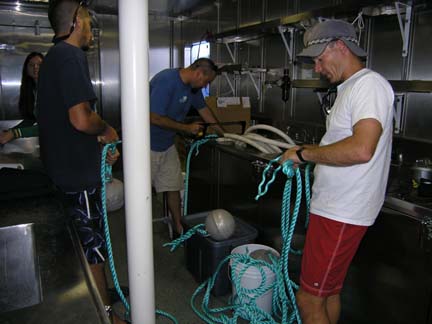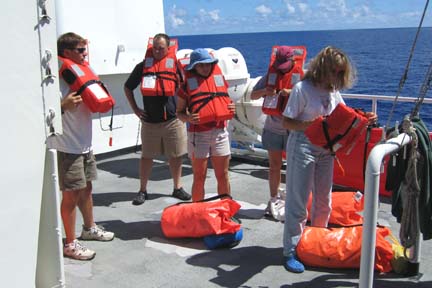|
You
are here: /main/research
expeditions/ 2005 RAMP/8_28_05
The Transit
8/28/05,
The Transit Continues
by
Kelly Gleason, Maritime Archaeology

Coral biologist Iliana Baums works in the NOAA Ship
Hi`ialakai's wet lab to prepare numbered tags for
coral specimens.
Today is our last full day of transit before we arrive at
our first destination in the NWHI: French Frigate Shoals.
For the scientists, this is the last day to check dive gear,
make sure data sheets are in order, and make sure that all
field gear has been tested and is ready to go for the first
day. There are dozens of items for the scientists to remember
to bring on a research cruise. In addition to a bag full of
dive gear, most scientists bring with them tons of waterproof
paper, an assortment of measuring devices, floats, underwater
cameras, and various other types of specialized gear to get
the job done. Inevitably, there are items that don’t
work, or have been left behind, and days like this are spent
figuring out how to fix those kinds of issues.

Shark
biololgists Yannis Papastamatiou (L) and Carl Meyer (R) prepare
acoustic tag receiver mooring lines with assistance from Matt
Craig (center).
On
transit days before the field work has begun, the wet lab
is usually buzzing with preparation activity and today was
no different. Coral biologists Jen Salerno and Iliana Baums
were busy setting up field gear so that they will be able
to mark and document the specific corals that they will be
collecting for laboratories back in Honolulu. Yannis Papastamatiou
and Carl Meyer were setting up their long lines and gear for
bringing in the sharks and large jacks that they will be tagging
over the course of the trip.

Scientific
staff and crew try on PFDs (personal flotation devices)
during an abandon ship drill. L to R: chamber operator Jim
Bostick,
medical officer Mike Futch, Iliana Baums, Cheryl Squair, Greta
Aeby.
The
only thing that interrupts the pace of preparation is the
mandatory drills that usually take place on a transit day.
A fire drill and abandon ship drill gave us the opportunity
to go over all the scenarios that we hope will never happen
while we are out at sea. Safety is a very real issue in a
remote location like the NWHI, and the ship also has personal
EPIRBs (Emergency Position Indicating Radio Beacons) for us
to take with us when we dive.
Everyone is settling in and ready to make the NOAA Ship Hi’ialakai
their laboratory, office and home for the next five weeks.
Return
to Expedition main page
|